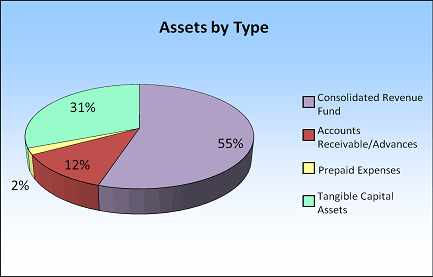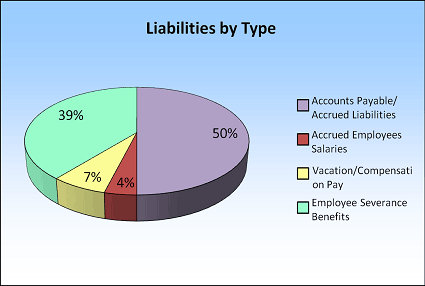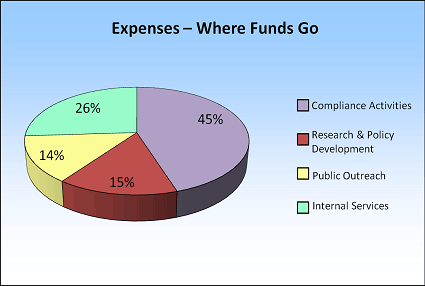Common menu bar links
Breadcrumb Trail
ARCHIVED - Office of the Privacy Commissioner of Canada - Report
 This page has been archived.
This page has been archived.
Archived Content
Information identified as archived on the Web is for reference, research or recordkeeping purposes. It has not been altered or updated after the date of archiving. Web pages that are archived on the Web are not subject to the Government of Canada Web Standards. As per the Communications Policy of the Government of Canada, you can request alternate formats on the "Contact Us" page.
Section III: Supplementary Information
This section presents the financial highlights for 2010-2011 and a supplementary information table. Audited financial statements are available on the OPC website. More information about the OPC, such as statutory annual reports and other publications, may be found on the OPC website or by contacting the Office toll-free at 1-800-282-1376.
3.1 Financial Highlights
| % Change | 2010-2011 ($000) |
2009-2010 ($000) |
|
|---|---|---|---|
| Total Assets | 59% | 5,421 | 3,411 |
| Total Liabilities | 32% | 6,835 | 5,172 |
| Total Equity | 20% | (1,414) | (1,761) |
| Total | 59% | 5,421 | 3,411 |
| % Change | 2010-2011 ($000) |
2009-2010 ($000) |
|
|---|---|---|---|
| Total Expenses | .02% | 24,812 | 24,808 |
| Net Cost of Operations | .02% | 24,812 | 24,808 |

Total assets were $5.421M at the end of 2010-2011, an increase of $2.01M (59 percent) over the previous year’s total assets of $3.411M. Of the total assets, $3.004M (55 percent) was to be received from the Consolidated Revenue Fund. Tangible capital assets represented 31 percent of total assets, while accounts receivable and advances made up 12 percent and prepaid expenses, two percent of total assets.

Total liabilities were $6.835M at the end of 2010-2011, an increase of $1.663M (32 percent) over the previous year’s total liabilities of $5.172M. Accounts payable and accrued liabilities represented the largest portion of liabilities, at $3.392M, or 50 percent of the total. Employee severance benefits represented a slightly smaller portion of the total liabilities, at $2.65M, or 39 percent. Vacation pay and compensatory pay and accrued employee salaries accounted for seven percent and four percent of total liabilities, respectively.

Total expenses for the OPC were $24.812M in 2010-2011.The largest share of the funds, $11.131M, or 45 percent, was spent on compliance activities, while research and policy development represented $3.721M, or 15 percent, of total expenses. Public outreach efforts represented $3.612M of the expenditures, or 14 percent of the total. Internal Services accounted for the remainder of the expenditures, at $6.348M or 26 percent of the total.
Audited Financial Statements
Information on OPC's audited financial statements can be found at the following link: http://www.priv.gc.ca/information/an-av_e.cfm
3.2 Supplementary Information Tables
The OPC has a single supplementary table as follows:
Table 10 - Internal Audit and Evaluation
Approved internal audit and evaluation reports are available on the OPC website: http://www.priv.gc.ca/aboutUs/iac_e.cfm
[1] Reference is made to "individuals" in accordance with the legislation.
[2] The TBS scale for performance status refers to the proportion of the expected level of performance (as evidenced by the indicator and target or planned activities and outputs) for the priority or result identified in the corresponding Report on Plans and Priorities that was achieved during the fiscal year. The ratings are: exceeded – more than 100 percent; met all – 100 percent; mostly met – 80 to 99 percent; somewhat met – 60 to 79 percent; and not met – less than 60 percent.
[3] Type is defined as follows: previous – committed to in one of the past two Reports on Plans and Priorities (RPP) that correspond to this DPR; ongoing – committed to at least three fiscal years prior to the RPP that corresponds to this DPR; and new – newly committed to in the RPP that corresponds to this DPR.
[4] The data relating to PIPEDA files is for 12 months from January to December 2010 while the data for Privacy Act files is for 12 months from April 2010 to March 2011. With a redesign of the management information system currently underway, next year’s report will present all data on a fiscal year basis.
[5] The 2010-2011 Report on Plans and Priorities referred to this priority privacy issue as ‘national security’.
[6] Audit reports made public in 2010-2011 were: Audit of the Personal Information Disposal Practices in Selected Federal Institutions, Oct. 5, 2010; Audit of the Protection of Personal Information in Wireless Technology - An Examination of Selected Federal Institutions, Oct. 5, 2011; and Audit of Selected Mortgage Brokers, June 8, 2010.
[7] This performance indicator/target has been eliminated as it did not accurately reflect the OPC’s performance.
[8] The OPC is developing new service standards based on its re-engineered processes. The new standards will become the basis to report on the timeliness of responses-- i.e., the percentage of inquiries and complaints that are completed within the set service standards. This Departmental Performance Report presents actual turnaround times.
[9] The data relating to PIPEDA files is for 12 months from January to December 2010 while the data for Privacy Act files is for 12 months from April 2010 to March 2011.
[10] Targets are to be revisited once the OPC reaches full capacity.
[11] In addition to the published audits listed in footnote 6, three other audits were substantially completed during the fiscal year and were to be published after the end of the reporting period. They examined Staples Business Depot; privacy and aviation security, and selected RCMP operational databases.
[12] Audits followed up on in 2010-2011 focused on RCMP exempt databanks (2008), Canadian passport operations (2008), and the privacy management frameworks within selected federal institutions (2009).
